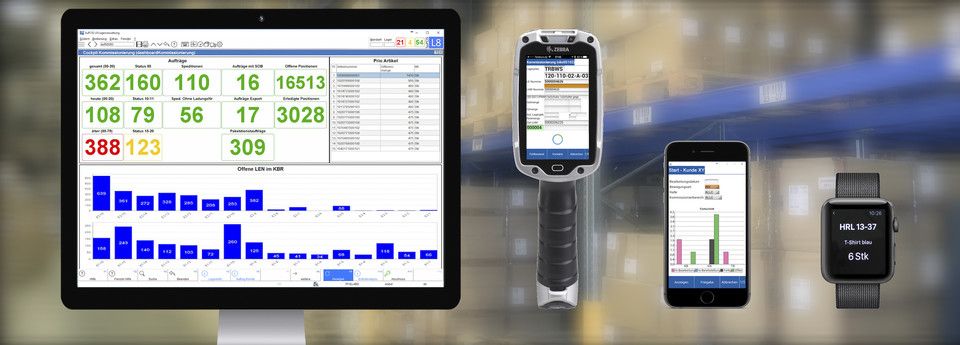Warehouse management systems (WMS) are software-based systems for the management of logistics centers (warehouses and distribution centers) - from the receipt of goods to the management of the storage areas for items in automatic or manual high bay warehouses, small container storage units or shelves Goods issue and dispatch.
With warehousing management software, logistics software, intralogistics software or warehouse management systems, the complete internal material flow can be displayed. Thus, a warehouse management system is responsible for the control and optimization of complex warehouse and distribution systems. In addition to the basic core functions, such as volume and stock management, extensive functions are also integrated in a WMS to check the system states and to calculate and define operating and optimization strategies. This includes, among other things, the handling of subcontracting, shipping and picking processes. An example of these features can be found below.
The VDI (Association of German Engineers) published the VDI guideline 3601 in September 2015, which deals explicitly with the question of what an IT system has to do in order to be designated as WMS.
According to this guideline, a warehouse management system is "the management, control and optimization of storage and distribution using a software system (including storage and storage management, as well as the management and administration of the equipment), with extensive methods and means for checking the system conditions and with a selection of operational and optimization strategies. The task of a warehouse management system (WMS) is to manage and optimize in-house storage and transport systems. "
In summary, it can be said that a warehouse management system (WMS) is a highly complex software structure in which a multitude of functionalities are implemented. It represents the central unit in the software structure for the management of a warehouse. The WMS receives orders from the overlying host system, mostly an ERP system, manages these in a database and, after appropriate optimization, supplies them to the connected conveyor systems.
Thus, a modern warehouse management system controls all intralogistic processes from the goods receipt to the dispatch, documents them and optimizes them with the aim of storing as few goods as possible (stored goods = tied capital), using few resources and personnel for storage and delivery to the end customer.
What is a Warehouse Management System?
Overview of the functionalities of a WMS
CORE / BASIC FUNCTIONALITIES
Essential functionalities
- Warehouse structure
- Master Data Management
- Inventory management
- Transportation management
Incoming goods
- Advanced shipping note
- Receipt
- Deconsolidation
- Quality inspection
- Storing
Warehouse-internal processes
- Relocation
- Replenishment
- Rebooking
- Cockpit (control centre)
- Stock-taking
Outgoing goods
- Order management
- picking
- consolidation
- packing
- dispatch
ADDITIONAL FEATURES
- Management of several warehouses
- Multiple client capability
- Consignment
- Kit building
- Management of serial numbers and best before dates
- Production supply
- Resource planning
- Returns management
- Value Added Services
- Customs
- Batch management
- Dangerous goods
- Weight control
- Package optimization
- Empties / charging auxiliary resource management
- Cross docking
- Dock and yard management
- Double and multiple depth storage
- Forklift control system
Most warehouse management systems are modular, so that the core function can be supplemented as required by additional functions and modules (for example pick-by-voice or RFID subsystems).

This is what a warehouse management system can look like on different devices.

